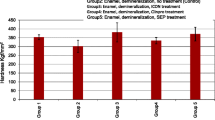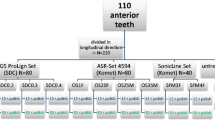Abstract
Objectives
The aim of this in vitro study was to investigate the demineralization rate in human enamel after interproximal polishing (IPP) and to detect possible correlations with the IPP method used, with special emphasis on the surface characteristics of the enamel being treated.
Materials and methods
This in vitro study tested five IPP systems (Profin Directional System®, Intensiv ProxoStrip®, OS discs®, ARS Safe-Tipped Bur Kit® and Ortho-Strips Set®) that are currently available on the market. Each of the five examination groups comprised 12 randomly selected teeth, while the control group consisted of six teeth. The teeth were placed in an artificial model for each group. The proximal contacts were then resolved by IPP. To allow detection of any surface characteristics, one surface was not further processed after IPP, while the other side was additionally polished. After IPP, the teeth were exposed to a pH-cycling model with alternating phases of demineralization and remineralization. Substance loss was analyzed using optical emission spectrometry. Data were subjected to simple analysis of variance (ANOVA) performed with Tukey’s test. Comparison between the groups with and without polishing was conducted using the t test for independent samples. The significance level was set at p < 0.05.
Results
Demineralization significantly increased after IPP. The rates of demineralization differed significantly among the examination groups, with the greatest loss of substance being produced with Sheridan’s Air-Rotor Stripping® system (ARS; 145.34 ± 20.37 μm). In all of the examination groups, subsequent polishing of the surfaces did not significantly reduce the amount of demineralization (polished 119.64 ± 28.61 μm; unpolished 114.16 ± 28.61 μm).
Conclusion
No correlation between surface morphology and the degree of susceptibility of human enamel was detected. However, it must be taken into consideration that there was no potential bacterial colonization in this in vitro erosive set-up. Thus, in contrast to previous explanations, the outermost fluorapatite layer and the individual composition of the enamel may have a greater impact on the solubility of the enamel and the amount of enamel loss after IPP than the type of system used and the resulting surface texture.
Clinical relevance
Whenever the outermost layer of enamel is reduced, the practitioner must expect an increase in demineralization. Subsequent polishing does not appear to affect the amount of demineralization.


Similar content being viewed by others
References
Sheridan JJ (1985) Air-rotor stripping. J Clin Orthod 19:43–59
Sheridan JJ (1987) Air-rotor stripping update. J Clin Orthod 21:781–788
Sheridan JJ, Ledoux PM (1989) Air-rotor stripping and proximal sealants. An SEM evaluation. J Clin Orthod 23:790–794
Radlanski RJ, Jäger A, Schwestka R, Bertzbach F (1988) Plaque accumulations caused by interdental stripping. Am J Orthod Dentofacial Orthop 94:416–420
Thordarson A, Zachrisson BU, Mjör IA (1991) Remodeling of canines to the shape of lateral incisors by grinding: a long-term clinical and radiographic evaluation. Am J Orthod Dentofacial Orthop 100:123–132
Hein C, Jost-Brinkmann PG, Schillai G (1990) The enamel surface quality after interproximal stripping—a scanning electron microscopic assessment of different polishing procedures. Fortschr Kieferorthop 51:327–335
Piacentini C, Sfondrini G (1996) A scanning electron microscopy comparison of enamel polishing methods after air-rotor stripping. Am J Orthod Dentofacial Orthop 109:57–63
Danesh G, Hellak A, Lippold C, Ziebura T, Schafer E (2007) Enamel surfaces following interproximal reduction with different methods. Angle Orthod 77:1004–1010
Ganss C, Lussi A, Klimek J (2005) Comparison of calcium/phosphorus analysis, longitudinal microradiography and profilometry for the quantitative assessment of erosive demineralisation. Caries Res 39:178–184
Kim KN, Yoon YJ, Kim KW (2001) A study of the enamel surface texture and caries susceptibility in interdentally stripped teeth. Korea J Orthod 31:567–578
Ten Cate JM, Timmer K, Shariati M, Featherstone JD (1988) Effect of timing of fluoride treatment on enamel de- and remineralization in vitro: a pH-cycling study. Caries Res 22:20–26
Weatherell JA, Robinson C (1973) The inorganic composition of teeth. In: Zipkin I (ed) Biological mineralization. Wiley, New York, pp 43–74
Nikiforuk G (1985) Understanding dental caries, vol. 1: etiology and mechanisms. Karger, Basel pp 95–109
Kapur KK, Fisher EE, Manly RS (1961) Effect of surface alteration in the permeability of enamel to a lactate buffer. J Dent Res 40:1174–1182
Twesme DA, Firestone AR, Heaven TJ, Feagin FF, Jacobson A (1994) Air-rotor stripping and enamel demineralization in vitro. Am J Orthod Dentofacial Orthop 105:142–152
Brudevold F, Tehrani A, Bakhos Y (1982) Intraoral mineralization of abraded dental enamel. J Dent Res 61:456–459
Crain G, Sheridan JJ (1990) Susceptibility to caries and periodontal disease after posterior air-rotor stripping. J Clin Orthod 24:84–85
Jarjoura K, Gagnon G, Nieberg L (2006) Caries risk after interproximal enamel reduction. Am J Orthod Dentofacial Orthop 130:26–30
Radlanski RJ, Jager A, Zimmer B (1989) Morphology of interdentally stripped enamel one year after treatment. J Clin Orthod 23:748–750
Lehmann KM, Hellwig E (2005) Zahnärztliche propädeutik. Urban & Fischer, Munich, p 32
Zachrisson BU, Minster L, Ogaard B, Birkhed D (2011) Dental health assessed after interproximal enamel reduction: caries risk in posterior teeth. Am J Orthod Dentofacial Orthop 139:90–98
Artun J, Thylstrup A (1989) A 3-year clinical and SEM study of surface changes of carious enamel lesions after inactivation. Am J Orthod Dentofacial Orthop 95:327–333
Mannerberg F (1968) Appearance of the tooth surface of teeth showing dental fluorosis as observed by shadowed replicas. Odontol Revy 19:271–291
Zachrisson BU, Arthun J (1979) Enamel surface appearance after various debonding techniques. Am J Orthod 75:121–127
Ganss C, Klimek J, Schwarz N (2000) A comparative profilometric in vitro study of the susceptibility of polished and natural human enamel and dentine surfaces to erosive demineralization. Arch Oral Biol 45:897–902
El-Mangoury NH, Moussa MM, Mostafa YA, Girgis AS (1991) In-vivo remineralization after air-rotor stripping. J Clin Orthod 25:75–78
Zachrisson BU, Nyøygaard L, Mobarak K (2007) Dental health assessed more than 10 years after interproximal enamel reduction of mandibular anterior teeth. Am J Orthod Dentofacial Orthop 131:162–169
Conflict of interest
The authors declare that they have no conflicts of interest.
Author information
Authors and Affiliations
Corresponding author
Rights and permissions
About this article
Cite this article
Hellak, A.F., Riepe, E.M., Seubert, A. et al. Enamel demineralization after different methods of interproximal polishing. Clin Oral Invest 19, 1965–1972 (2015). https://doi.org/10.1007/s00784-015-1429-0
Received:
Accepted:
Published:
Issue Date:
DOI: https://doi.org/10.1007/s00784-015-1429-0




